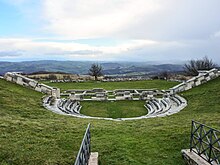Province Of Isernia
History
Isernia was known as Samnite Aesernia until it fell under Roman rule in 263 BC. The territory was later given to Alczeco for his efforts against the Byzantines with his Bulgarian military, by the Duchy of Benevento; most of this territory became Molise County. Throughout the 9th century the area was repeatedly sacked during Muslim invasions and suffered an earthquake in 847; these destroyed the cities of Isernia and Venafro. Despite this, the city was made an episcopal see and was granted the status of county in 964. A 1979 archaeological discovery near the city of Isernia found evidence of a settlement dating back to the Palaeolithic period over 736,000 years ago.
In Molise County, Benedictines formed the San Vincenzo al Volturno monastery in the province of Isernia after Rome fell in 476. When the area was invaded by the Muslims, 500 to 900 monks were decapitated by them and many were taken as slaves; despite this, the monastery continued to function and reached its peak size during the eleventh and twelfth centuries. Pope Celestine V was born near Isernia and the province's feast day is on 19 May, the date Celestine V was canonized. An earthquake in 1805 destroyed Isernia's cathedral, which was rebuilt atop the ruins of the destroyed structure in 1837.
The province gained attention during the COVID-19 pandemic in Italy, as by 15 March it was the only one of Italy's 110 provinces to not have a single confirmed case of the COVID-19 virus.
Geography

The province of Isernia is a largely mountainous area of south-central Italy, part of the region of Molise. To the southwest the mountains decrease in height and the wooded hills give way to the plains around Venafro. To the northeast is the province of Campobasso, also part of Molise, and to the north the provinces of L'Aquila and Chieti, both in the region of Abruzzo. To the west is the province of Frosinone in Lazio and to the south the province of Caserta in Campania.
There are four mountain ranges in the province and the Abruzzo National Park straddles the border with Abruzzo. The highest peak in the province is Monte Mare, 2,020 metres (6,627 ft). The main rivers are the Volturno which flows into the Tyrrhenian and the Trigno which flows into the Adriatic. The lake of Castel San Vincenzo is a man-made reservoir built to power a hydroelectric scheme.
The economy of the region has been traditionally based on agriculture. The holdings are mostly small and produce grapes, cereals, olives, vegetables, fruit and dairy products. Traditional products grown in the province include grass peas (Lathyrus sativus) and farro, which is made from a specialist form of wheat. Tintilia grapes are grown for the production of the region's red wine, the "Tintilia del Molise".
References
- ^ Regions and Cities > Regional Statistics > Regional Economy > Regional Gross Domestic Product (Small regions TL3), OECD.Stats. Accessed on 16 November 2018.
- ^ "Presidenza della Provincia di Isernia: Alfredo Ricci batte il «centrodestra ufficiale» e vince la sfida con Felice Ianiro. Di Baggio: «Qualcuno aveva fatto i conti senza l'oste»". PrimoPiano Molise (in Italian). 2019-08-25. Retrieved 2020-01-09.
- ^ "Isernia". Tutt Italia. Retrieved 17 August 2015.
- ^ "Statistics". Upinet. Archived from the original on 7 August 2007. Retrieved 17 August 2015.
- ^ Roy Palmer Domenico (2002). The Regions of Italy: A Reference Guide to History and Culture. Greenwood Publishing Group. pp. 226–227. ISBN 978-0-313-30733-1.
- ^ Zunino, Corrado (15 March 2020). "Coronavirus, il fortino di Isernia: "Siamo gli ultimi senza un contagio"" [Coronavirus, the fortress of Isernia: "We are the last ones without an infection"]. La Repubblica (in Italian). Retrieved 15 March 2020.
- ^ "Isernia è l'unica provincia italiana senza casi positivi al coronavirus" [Isernia is the only Italian province without positive cases of coronavirus] (in Italian). TGCOM24. 15 March 2020. Retrieved 15 March 2020.
- ^ The Times Comprehensive Atlas of the World (13 ed.). Times Books. 2011. p. 76. ISBN 9780007419135.
- ^ "Vino Tintilia del Molise". In vino veritas et benignitas. Archived from the original on 30 April 2018. Retrieved 21 August 2015.

